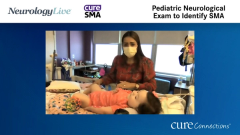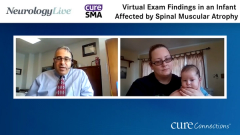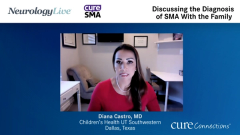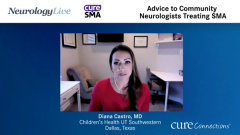
Signs and Symptoms of SMA
The signs and symptoms leading a pediatrician to a diagnosis of spinal muscular atrophy (SMA) are discussed.
Episodes in this series

Garey H. Noritz, MD: In a place that doesn’t have newborn screening yet, you’re really relying on the eyes, ears and hands of pediatricians, family doctors, physical therapists and families to recognize when there is something not right about the child. What are those things we should be looking for?
Diana Castro, MD: I have a certain way of thinking about a patient with spinal muscular atrophy [SMA], at least with type 1. There are different types, and the ones you and I will get exposed to as pediatricians will mainly be types 1, 2, and 3. Type 4 is usually adult patients who we’re not going to see. Let’s concentrate first on type 1. I always tell my residents and my fellows to think of a patient whose face does not go very well with the body. Why? Because you have a face that is completely normal. Usually these kids are beautiful. They are extremely alert. They look around. They seem to understand everything even better than other children do. When you start looking down at their body, it is a disconnect. It’s almost like their body is not connecting well with their face. With their body, you’re going to see low muscle tone. You’re going to see a patient who has really limited mobility. Sometimes they cannot pick up their legs. Most of the time, the legs are the first to be affected. Then we see start seeing other things, such as breathing abnormalities.
Those are the key points: a patient with very low tone and weakness with a face that does not seem to match. Fasciculations are also something I would look for. The problem is that sometimes fasciculations are hard to evaluate. Some of them may look like tremors in the tongue, but I prefer to get a referral to identify whether they’re tremors or fasciculations. If you’re looking for patients who fit type 2 and type 3, type 2s usually will only be able to sit. That will be the key point where the parents get concerned because the patient is not going to be able to stand up and walk. That’s usually the referral point.
Pediatricians, I’m sure it’s sometimes hard for you to get reflexes checked, but I think it’s key. If you have a type 2, you’re not going to find reflexes. You’re going to have a patient with very decreased or absent reflexes. In the setting of a kid who has low tone and cannot stand up, that’s a patient with SMA who should be referred to us. Type 3 patients usually take longer to get diagnosed, but it’s a kid who is able to stand up. It’s a kid who’s able to walk. Around 8 to 10 years of age, they will start having several falls, will start getting fatigued, and so on. I think that’s the most difficult to diagnose, and that’s usually the one who takes longer to get to the diagnosis, but it’s something to keep in mind. It’s something that we have to think about.
Garey H. Noritz, MD: Thank you for watching this NeurologyLive® Cure Connections® program. If you enjoyed the content, please subscribe to our e-newsletters to receive upcoming programs and other great content right in your inbox.
Transcript Edited for Clarity
Newsletter
Keep your finger on the pulse of neurology—subscribe to NeurologyLive for expert interviews, new data, and breakthrough treatment updates.














































